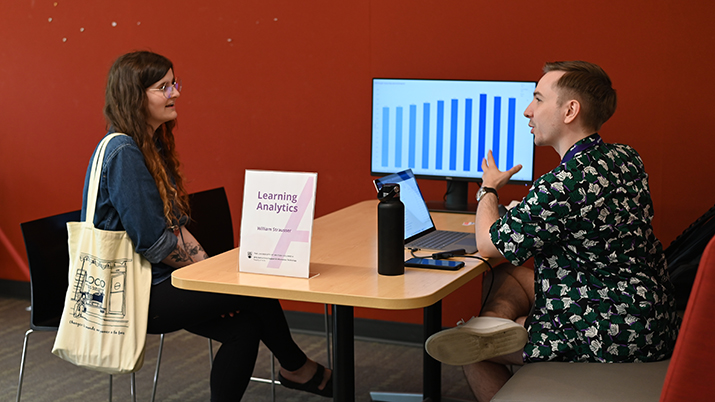

–Fred Cutler, Associate Professor (POLI)
Description
The students gather sources of all kinds that will contribute to an understanding of a policy area- the “total policy landscape” as I call it. They curate the materials, categorize them, and decide as a group how to remix and present that information to explain what is going on in their particular policy area. Students develop their ability to search online for a wide variety of types of information and organize it for maximum comprehension for their audience.
Goals
My intention is to give the students an opportunity to experience the kind of work they would do in a government or a non-governmental organization where the broad policy context needs to be understood. A big part of that is learning how to write clear prose in a professional mode, so I have them produce content for a website that could potentially be visible to the public. That kind of writing is very challenging for our students, as they’re socialized into academic writing and have trouble simplifying their writing style. So in the class we reorient them and have them write in a style that is more typical of effective writing in the careers that they are likely to pursue.
Objectives
- Develop students’ understanding of the total context, or ‘landscape’, of a specific policy area or cause, including its actors, organizations, ideas, and economic and social context
- Develop students’ ability to write in a professional manner outside of an academic context
- Develop students’ ability to find and curate information available online
Level of Difficulty: High
Course: POLI 308 (“Issues in Canadian Politics”)
Number of Students: Small to medium (30-50 students)
Delivery: Synchronous and asynchronous
Time: 1 full course length
Keywords: student engagement, peer learning, community building, collaborative work
Learning Activities
Group Project
Delivery: Synchronous and asynchronous
Prep Work
- Separate students into groups of 5-7
- Prepare a space for students to manage information, collaborate, and produce content, either on Notion or elsewhere
- Brief students on the structure for the project
Method
The group project is one semester-long activity. Students do several things – they gather information, they categorize it, they decide on its relevance, organize it, and then present it. They use a wide variety and a large number of sources, so to manage those sources I have them use a database. The students use a platform called Notion to sort and categorize their sources, which may include policy documents, news stories, public opinion surveys, academic analyses, parliamentary debates, or records of events like speeches, demonstrations, or community consultations.
The next step is assigning properties in the database, such as how relevant something is, what aspects of the issue it touches, and what is the source of the information. This gives students some skills in using a database and using a systematic approach to information-curation. Students use their Notion space also for the writing of content for a website. The website is guide to the total policy landscape for the issue.
Over three years, some of these projects have been made available at issueguides.ca. A previous iteration of the course, with the whole class as one group, produced uvotebc.ca, a site to inform citizens as they made their decision in the British Columbia Electoral Referendum of 2018. In these projects the focus is on writing to directly communicate facts rather than make an argument. The students are often reporting or distilling the arguments of the participants involved in a policy discourse. In the final few weeks of the course, there is a focus on developing skills of editing, and giving and receiving feedback.
Grading
Assessment is, naturally, suited to the student production in the course, which is more about process than the final group product. An individual course log carries the most weight. Students are expected at least two to three times a week to write a log entry on what they did, what challenges they faced, how they overcame those challenges, and the skills they were developing. I also have them do a peer evaluation for a small part of the grade, where they assess the contributions of the other members of their group. To connect the course to career skills development, they make an ePortfolio using the ubcarts.ca platform. The portfolio is a space to articulate some of the things they have done in the course, along with some of the other career-relevant experiences they have had outside the course.
Discussion and Reflection
Did you feel the students achieved your intended learning outcomes for the course? Why or why not? What did students share about their experience?
Yes, I think that the students achieved the intended learning outcomes. They are all starting at different levels with some of these skills, so for many of the students it is a big challenge. By the end of the term, I’ve found that they are of the view that it was a real struggle, but they are glad to have done it. Many can see that their skills have improved, and others have gained an idea of the kind of skills that would be required in their careers. The students are generally happy to have had an opportunity to practice those skills and develop them a bit.
What are some changes or improvements which you wish to include in the future?
I am learning that I have to provide the students with modeling of the skills. But I worry about doing it too much, because their educational socialization is just to mimic the things exactly as they are shown. I feel this tension where I do not want to show them how to do some things in too much detail because they will likely try to match what I show them too strictly. So, I would like to find the right balance on that. I would also like to have them figure out the style of writing for this course earlier in the course, so it is not such a struggle later. I need to provide more assignments, earlier, to practice this kind of writing. I would also like the course to have more community impact and may try to connect the projects to organizations in the community more explicitly.
Do you have any suggestions for instructors considering Practical Learning for their course?
I would say to be prepared for more of an emotional journey, to the extent you are unsettling the ways that students do the sorts of academic production that are typical in their courses up to that point in their studies. Be prepared for them to be uncomfortable, and for you to have to coach them. I would say that group work always has some predictable challenges, which you need to accept, and the grading should be more aligned with the effort that the students have put in. On the tech side, my advice is to find the right student group work collaboration platform and provide it to them as a structure. I use Notion because it can be a collaboration space as well as a website without having to build a website separately. But I know that instructors can just have students use Google Docs, where you would mandate certain ways of organizing information and naming conventions for folders and files. Google docs are best for giving feedback on ongoing student work throughout the term.
Practical Learning with Dr. Fred Cutler
Want to bring alumni into your classes?
Tell us more: Practical Learning in the Classroom


